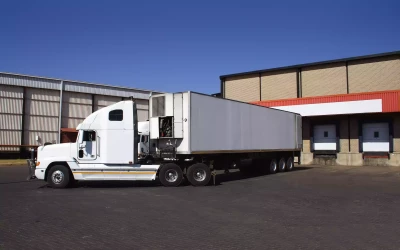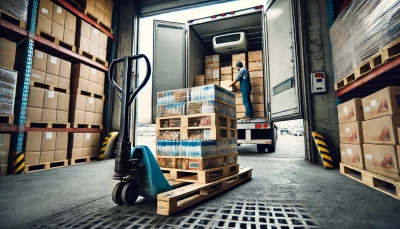Temperature Control Issues in the Cold Chain: Lessons from Real-World Scenarios
September 17, 2024
 Maintaining proper temperature control in the cold chain is crucial for ensuring the safety and quality of temperature-sensitive goods. As a trusted 3PL provider, Triple T Transport has seen firsthand the challenges that arise when temperature-sensitive shipments go awry. Real-world examples reveal how important it is for shippers, carriers, and receivers to be on the same page when it comes to maintaining product integrity and mitigating risks in the cold chain.
Maintaining proper temperature control in the cold chain is crucial for ensuring the safety and quality of temperature-sensitive goods. As a trusted 3PL provider, Triple T Transport has seen firsthand the challenges that arise when temperature-sensitive shipments go awry. Real-world examples reveal how important it is for shippers, carriers, and receivers to be on the same page when it comes to maintaining product integrity and mitigating risks in the cold chain.
One of the key factors in temperature-controlled shipping is the ability to monitor and document the temperature of the product at every step in the process. From the shipper to the receiver, each party plays a vital role in ensuring the goods remain within the required temperature range. This includes using tools such as reefer downloads, temperature recorders, and pulp thermometers to verify that the product is being handled correctly.
For instance, large retailers such as Walmart have stringent processes in place to avoid accepting goods that fall outside temperature specifications. They even require drivers to provide box temperature readings at the guard shack before allowing shipments to proceed. If the product is not within the acceptable temperature range, it is automatically rejected. This proactive approach helps prevent potential problems further down the line.
Despite best practices, there are times when a shipment arrives at the receiver and is rejected due to temperature issues. In these cases, it’s important to identify the root cause of the problem. Was the issue due to improper handling by the carrier, or did something go wrong at the receiver’s end?
What steps can shippers and carriers take to prevent temperature issues at the receiving end? Find practical solutions in the latest episode of the Stay In Your Lane Podcast.
In one such case involving from the dairy brand Organic Valley, a shipment arrived at the receiver on time and within the proper temperature range, yet the product was rejected after it sat in the dock for several hours. The extended exposure to warm air caused the temperature to rise, leading to the product being deemed “out of spec” upon inspection. The carrier was ultimately absolved of responsibility, as the reefer download showed the temperature was correct during transit. This highlights the importance of tracking not only the temperature in transit but also the conditions at the delivery point.
“This has gotten a lot of attention in our company,” says Organic Valley Director of Transportation Nathan Helms of the incident. “We’re going through and revamping our processes—documentation, communication paths…it’s certainly not as cut and dry as it used to be.”
When temperature-related issues arise, it’s essential for all parties to work together to resolve the situation. Poor communication or lack of coordination between shippers, carriers, and receivers can lead to unnecessary losses.
 For example, in a scenario where a product was rejected after sitting at the dock for too long, it became clear that there was a breakdown in the communication process. Had there been better documentation and notification protocols in place, the problem could have been identified sooner, potentially saving the shipment.
For example, in a scenario where a product was rejected after sitting at the dock for too long, it became clear that there was a breakdown in the communication process. Had there been better documentation and notification protocols in place, the problem could have been identified sooner, potentially saving the shipment.
Accountability and transparency are critical in preventing losses. It’s essential to establish clear processes for communication and documentation at every stage of the shipment. When all parties are aligned, it minimizes the risk of product spoilage and reduces the likelihood of costly rejections.
One recurring theme in temperature-controlled shipping is the need for standardized procedures. Many large retailers have implemented rigorous receiving protocols, but not all shippers and receivers follow the same guidelines. This inconsistency can lead to confusion and disagreements when things go wrong.
Some shippers, carriers, and receivers are beginning to adopt practices like temperature verification at the point of entry, which helps ensure the product is in good condition before unloading begins. As more companies implement these standards, it will lead to greater transparency and fewer disputes over temperature discrepancies.
Cold shipping is a complex process, and even minor errors can result in significant losses. By taking a proactive approach and fostering collaboration between all parties, many of these problems can be avoided. Use reefer downloads and temperature recorders to ensure the product stays within the required range from start to finish. Make sure that shippers, carriers, and receivers are aligned on when and how to communicate about potential temperature issues. Finally, the adoption of standardized processes across the industry would also help prevent disputes and reduce the risk of rejections.
At Triple T Transport, we strive to help our partners minimize loss, ensure accountability, and improve processes across the supply chain. That’s why we work hard to ensure all temperature-sensitive shipments receive the meticulous care they require. By working together, we can reduce waste, preserve product integrity, and achieve success for everyone involved.














